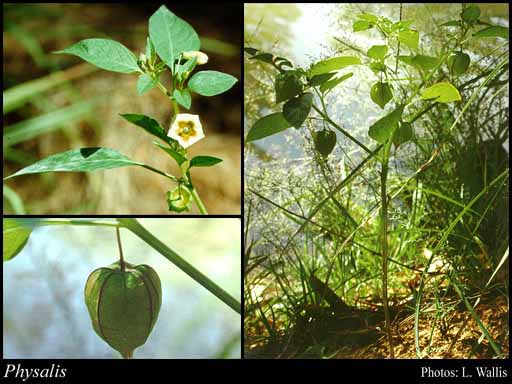- Reference
- Sp.Pl. [Linnaeus] 2:182 (1753)
- Name Status
- Current

Scientific Description
Common name. Cape Gooseberries. Family Solanaceae.
Habit and leaf form. Short lived shrubs, or herbs; resinous, or not resinous. Plants unarmed. Annual (summer growing), or perennial; plants with neither basal nor terminal concentrations of leaves. Stem internodes solid. The perennial species rhizomatous. Helophytic to xerophytic. Leaves alternate, or alternate to opposite (1 or 2 per node but not opposite, often in pairs); spiral; ‘herbaceous’, or leathery; petiolate; non-sheathing; simple; epulvinate. Leaf blades dissected, or entire; when dissected, pinnatifid; pinnately veined; cross-venulate. Leaves without stipules. Leaf blade margins dentate (or lobed). Leaves without a persistent basal meristem. Leaf anatomy. Hairs present, or absent; glandular hairs present. Extra-floral nectaries absent.
Reproductive type, pollination. Fertile flowers hermaphrodite. Unisexual flowers absent. Plants hermaphrodite. Entomophilous.
Inflorescence and flower features. Flowers solitary; axillary (or leaf-opposed, lateral or in forks of stems); pedicellate; ebracteate; ebracteolate; small to medium-sized; regular to somewhat irregular. The floral asymmetry when present, involving the androecium. Flowers 5 merous; cyclic; tetracyclic. Free hypanthium absent. Hypogynous disk present; intrastaminal. Perianth with distinct calyx and corolla; 10; 2 -whorled; isomerous. Calyx present; 5 (equal); 1 -whorled; gamosepalous; shortly 5 blunt-lobed; campanulate, or tubular; regular; persistent; accrescent (becoming inflated). Corolla present; 5; 1 -whorled; gamopetalous. Corolla lobes markedly shorter than the tube. Corolla contorted and plicate; campanulate (broadly), or rotate; regular; yellow (mostly, often with dark spots towards the base). Androecial members definite in number. Androecium 5. Androecial members adnate; all equal, or markedly unequal; free of one another; 1 -whorled. Androecium exclusively of fertile stamens. Stamens 5. Staminal insertion near the base of the corolla tube. Stamens all inserted at the same level; all more or less similar in shape; isomerous with the perianth; oppositisepalous (towards the base of the corolla tube). Filaments appendiculate, or not appendiculate. Anthers separate from one another; basifixed; dehiscing via longitudinal slits; introrse; bilocular; tetrasporangiate. Gynoecium 2 carpelled. The pistil 2 celled. Gynoecium syncarpous; synstylovarious to eu-syncarpous; superior. Ovary plurilocular; 2 locular. Gynoecium oblique; stylate. Styles 1; attenuate from the ovary; apical. Stigmas 1; 2 - lobed (L); capitate. Placentation axile. Ovules 20–50 per locule (numerous); non-arillate; anatropous, or hemianatropous.
Fruit and seed features. Fruit fleshy; indehiscent; a berry; 20–100 seeded (numerous). Seeds endospermic. Endosperm oily, or not oily. Cotyledons 2. Embryo curved (through more than a semicircle).
Economic uses, etc. Cape gooseberry, strawberry tomato, jamberberry, sugar cherry, chinese lantern etc., according to the species and variety.
Etymology. From the Greek for "bladder"; also applied to a plant with a bladder-like fruit, perhaps a species of this genus; refers to the enlarged calyx.